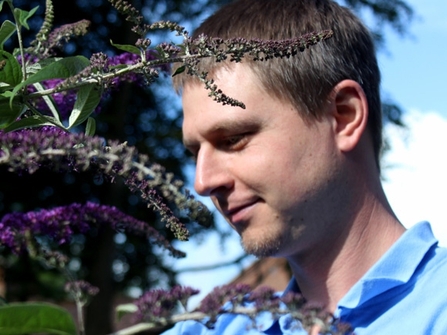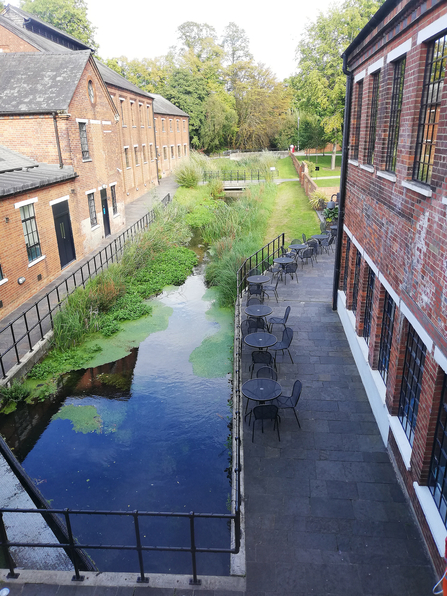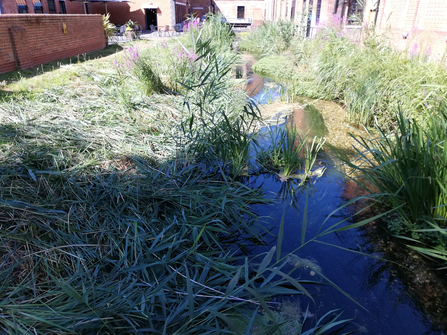
Chris Cotterell © Bombay Sapphire Distillery

Chris Cotterell © Bombay Sapphire Distillery
I’ve had an interest in nature for as long as I can remember, particularly when it comes to smaller creatures like insects. My first pets were Indian stick insects that lived in my bedroom, eating privet and bramble which I would ‘acquire’ from my neighbours’ gardens when no-one was looking. I had an interest in plants while at school, but the curriculum at the time only really covered photosynthesis as a biochemical process; I never actually grew anything.
During this time, I filled out a questionnaire at a careers day to help give me ideas for a job. I ticked the boxes for ‘working outside’, ‘don’t mind lifting heavy objects’, and ‘don’t mind getting dirty’. The questionnaire recommended I be an undertaker! Instead, when I left school I took a summer job as gardener - it was only ever meant to be a temporary thing, but I was hooked immediately.
In early 2014, I began working at the Bombay Sapphire Distillery in the village of Laverstoke. This was before the site was opened to the public, so I helped with the final stages of the building project - focusing on the construction of the glasshouses - and the site landscaping. My role since then has been to maintain and develop the site from a horticulture point of view.
I have also taken on a sustainability role, which involves evaluating and improving the way the site is managed from an environmental angle. The nature of my job means I can actively put my ideas from this role into practice, such as by redesigning some areas of the site to create new wildlife habitats, as well as improving the ones we already have.
The distillery owns the short stretch of the Upper Test that flows alongside it. The chalk stream doesn’t directly influence the distillation process, but we have installed a hydroelectric turbine to produce electricity for our buildings. Even though it wasn’t the reason why Bacardi chose the site, the stream was a welcome addition and continues to be so.

Restored chalk stream at the Bombay Sapphire Distillery in Laverstoke © Chris Cotterell
When I first joined the company, the chalk stream was in pretty bad shape. A previous owner had ‘channelised’ it by replacing the banks with concrete walls, and those had cracks that various leylandii and sycamore saplings were growing through. Straddling the banks were corrugated tin buildings that left at least half of the stream’s length in total darkness.
It wasn’t all bad news though – the derelict brick buildings, which had been unused for about 10 years, had quite a lot of birds and bats nesting in them. One particular building is still known as the ‘bat cave’ because they like to roost in the old roof. The quiet location and nearby lake meant that kingfishers, egrets, and herons would often visit, as would a pair of otters. Considering it had been a building site for about two years at this point, the fact it had wildlife at all was a miracle.
Once I had started my job, I got stuck in with further improvements. The tin buildings had outlived their useful life and so were removed, which had the bonus of allowing sunlight back into the chalk stream. The concrete banks were destroyed wherever possible, and replaced with soil that was then planted with wildflowers. This probably had the most significant impact on improving the habitat as a whole.
The stream’s bed was also heavily silted. Some sediment suspended in the water is normal: it gets there from decaying plant matter and run off from the surrounding area. A good flow in the stream keeps the sediment in suspension, until it is deposited along a bank or flows out to sea. But if the flow slows down too much, the sediment drops out and smothers the gravel bed, which is vital habitat for trout to spawn in and water crowfoot (Ranunculus aquatilis) to root in.
To keep this crucial habitat intact, we used a pressure washer to lift up the excess sediment from the bed. While this work was going on, we placed a Siltbuster filtering machine downstream to catch the suspended sediment and remove it from the water column. This meant that we could clear the sediment without it settling in another part of the stream and causing problems there.

Cutting of bank vegetation at the Bombay Sapphire Distillery in Laverstoke © Chris Cotterell
I was extremely surprised – and pleased – at how fast wildlife began to return. At the end of the first year after the works had finished, I found our first family of water voles. By the second year, they had spread all down the length of the stream, tunnelling through the banks and up into the adjacent lawns. I even had a pair that spent the winter living in the newly constructed glasshouse, eating coriander faster than I could plant it. The water crowfoot also appeared very quickly – without any intervention from me – and trout, grayling, and eels soon followed.
The soil that the landscapers used to reinstate the banks was very rich in comparison to that of a natural chalk stream, so the planted wildflowers grew to enormous proportions. This richness also led to nettles, thistles, and reeds taking over, but a good summer vegetation cutting regimen is helping to deal with it, and more diversity is slowly returning.
Today, the chalk stream is doing very well. Sarah Cooney (a volunteer with Watercress and Winterbournes) did an invertebrate survey for us recently, and I was pleasantly surprised at just how many creatures she found. It looks calm and peaceful to us, but it’s an insect superhighway in there! I am hoping that these surveys become a regular occurrence, as that would allow me to monitor the species diversity and know the impact of any changes I make.
Regular cutting of the bank vegetation in mid-to-late summer will remain important for many years, in order to reduce the soil nutrient levels and increase the number of species growing there. I am also hoping to introduce yellow-rattle (Rhinanthus minor) – which feeds off the nutrients in nearby grasses – as reducing their vigour would allow for greater plant diversity.
Control of invasive non-native species is also an ongoing issue. Pulling out orange balsam plants (Impatiens capensis) every year, before they seed, is a big task – you might know them as orange jewelweed or spotted touch-me-not. As I wasn’t on site during the recent lockdowns, their numbers have increased, which makes tackling them more difficult.
Pictured below (click to expand): The stream bank before and after the removal of orange balsam plants
I’ll admit to being nervous about taking on the chalk stream, even though it initially had very little life in it. I was repeatedly told, “It’s a Site of Special Scientific Interest: whatever you do, don’t make things worse”, but it was difficult to see how it could be worse. When plants started growing along the banks, and the water crowfoot began to return, I became more confident in what I was doing.
The greatest thrill has been seeing water voles return. I spotted a single family just before Christmas one year, at the very edge of our site, and have watched their territory spread down the length of the stream, to the point where we now have a very healthy population. I spent several years giving horticulture talks to groups, and I proudly spoke about the restoration of their habitat.
During these talks, it was common for reeds to be felled into the middle of the group and a water vole to pop out and drag its food back into the cover of the vegetation. I was often accused of secretly releasing them right on cue for the benefit of the group, but they had just become accustomed to people very quickly and weren’t going to let a lecture get in the way of their dinner!
Even now, I still get the same pleasure from seeing them swimming across the stream and watching where their network of burrows has taken them this year. My main interest now lies with the stream’s invertebrates though – I was quite amazed at the diversity that came out of Sarah’s recent survey, not to mention the numbers. I’m looking forward to seeing what gets found next time.
If you find yourself in a position to improve a chalk stream, as I have been, my advice is to just go for it! It’s not as difficult or as daunting as it first seems; I had almost no training or background in ecology, other than a keen interest. There’s a lot of help out there from not only books, but also knowledgeable people. The wildlife wants to return, it just needs a little helping hand from you to get there. You are far more likely to do good than harm, and if the chalk stream is already in a bad way, what have you got to lose?
We want to thank Chris for sharing this lovely story with us - his work is a real boon to the Upper Test. If you share his passion for our precious chalk streams, you can explore and support them through the Watercress and Winterbournes scheme.
We're always looking for people like Chris who are kind enough to share their personal experiences of our local chalk streams. You can read more wonderful stories, or share your own, through the Tales from the Riverbank project.